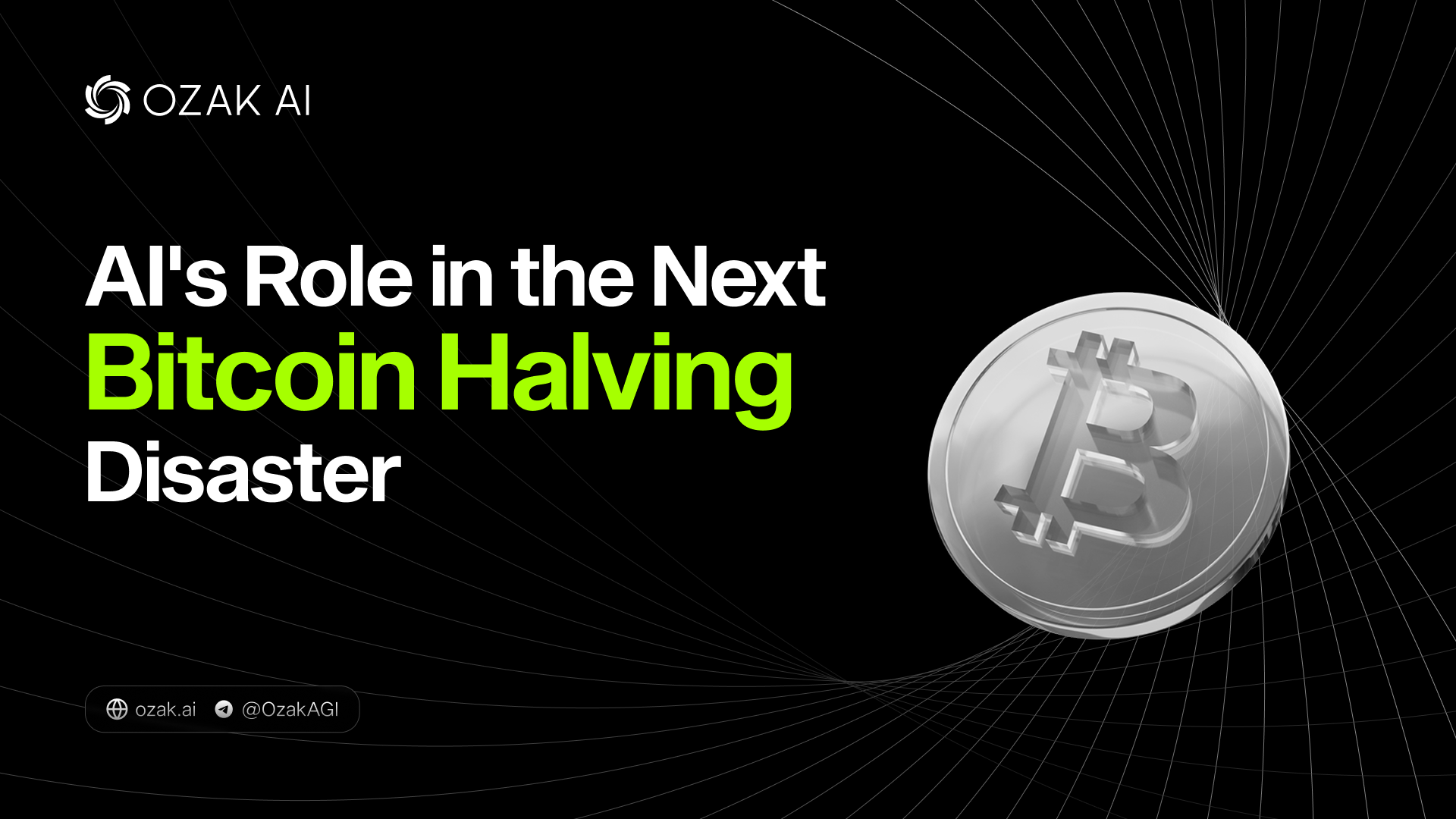
AI's Role in the Next Bitcoin Halving Disaster
Even if you're new to crypto, you know that Bitcoin's halvings are like those big events that can shake up the entire market. The 2024 halving happened on April 19th, and even though it's been over a year now here in late 2025, its effects are still playing out.
Prices have climbed since then, with Bitcoin sitting around $110,000 lately after some ups and downs. But here's the shocking truth: as we look ahead to the next halving around April 2028, artificial intelligence is stepping in big time, and it could either smooth things out or turn the whole cycle into a wild ride that feels like a disaster for a lot of folks.
Think about it – AI is already everywhere in trading, from bots that crunch data in seconds to predictive models that spot trends before humans can blink. With more institutions jumping in, using AI to handle massive trades, this tech is boosting efficiency but also ramping up volatility in ways we've never seen.
Historically, halvings cut the supply of new Bitcoins, which often leads to price booms as demand stays strong or grows. But now, with AI-driven tools possibly inflating bubbles or triggering quick sell-offs, the next one might not follow the old playbook.
In this post, we'll look into how AI could make things worse by amplifying market swings, or actually help prevent a meltdown with smarter predictions. We'll look at potential scenarios where Bitcoin hits highs like $145,000 or even $200,000 by the end of this year, but also ponder over the risks of flash crashes and over-optimized trading gone wrong.
Stick around as we break it down - because understanding this could be the key to turning a potential disaster into your next big opportunity.
Halving Mechanics and AI Influence

Navigating Bitcoin Halving Volatility
Let's start by breaking down what a Bitcoin halving actually is, because understanding this is key to seeing how AI fits into the picture.
Every four years or so - specifically, after every 210,000 blocks are mined - the reward that miners get for adding new blocks to the blockchain gets cut in half. This is baked right into Bitcoin's code to control inflation and mimic the scarcity of something like gold.
Right now, post-2024 halving, miners are earning 3.125 BTC per block instead of the previous 6.25.
The idea is simple: less new Bitcoin entering the market means supply tightens up, and if demand holds steady or grows, prices tend to go up.
Looking back at history, halvings have often been followed by big price jumps, but not without some drama along the way. Take the 2012 halving: Bitcoin was hovering around $12, and within a year, it shot up to over $1,000. The 2016 one saw a short-term dip of about 40%, but then it rallied hard, leading into the 2017 bull run. Fast forward to 2020, and we saw similar patterns - initial volatility, then a surge that took BTC to new highs by 2021.
The 2024 halving, which happened back in April last year, has already pushed prices higher overall, with Bitcoin climbing steadily amid spot ETF approvals and more mainstream adoption. But each time, the market's gotten more mature, with bigger players involved, which sets the stage for AI to shake things up.
Now, enter artificial intelligence, which is already playing a huge role in how Bitcoin and crypto are traded today. AI tools, like smart trading bots and predictive algorithms, can crunch massive amounts of data - from market trends to social media sentiment - in real time to make decisions faster than any human could.
We're seeing this in everything from AI-powered ETFs that automate investments to bots that handle high-frequency trades. Institutions are pouring money into these, with AI-driven strategies helping manage the wild swings in crypto volatility.
For example, by 2025, AI is expected to handle a massive chunk of global trading volume, including in decentralized markets like Bitcoin.
At Ozak AI, we're all about this kind of tech - our predictive models are designed to spot these patterns early, giving traders an edge.
But here's where it gets interesting and a bit concerning: AI could distort the traditional halving effects in ways that amp up the risks. Historically, price boosts came from organic supply-demand shifts, but now with AI bots reacting en masse to the same signals, we might see accelerated sell-offs during corrections or artificially inflated bubbles.
Imagine a bunch of algorithms all deciding to sell at once because they detect a minor dip - that could turn a normal pullback into a flash crash. On the flip side, institutional demand, fueled by AI-optimized portfolios, is driving inflows that account for a big portion of price returns, sometimes up to 35-40% based on recent trends.
This could make the next halving cycle, leading into 2028, more explosive but also more unpredictable, especially as AI integrates deeper into things like Ethereum ETFs and beyond.
It's exciting, but it means the old rules might not apply anymore.
Potential Disaster Scenarios
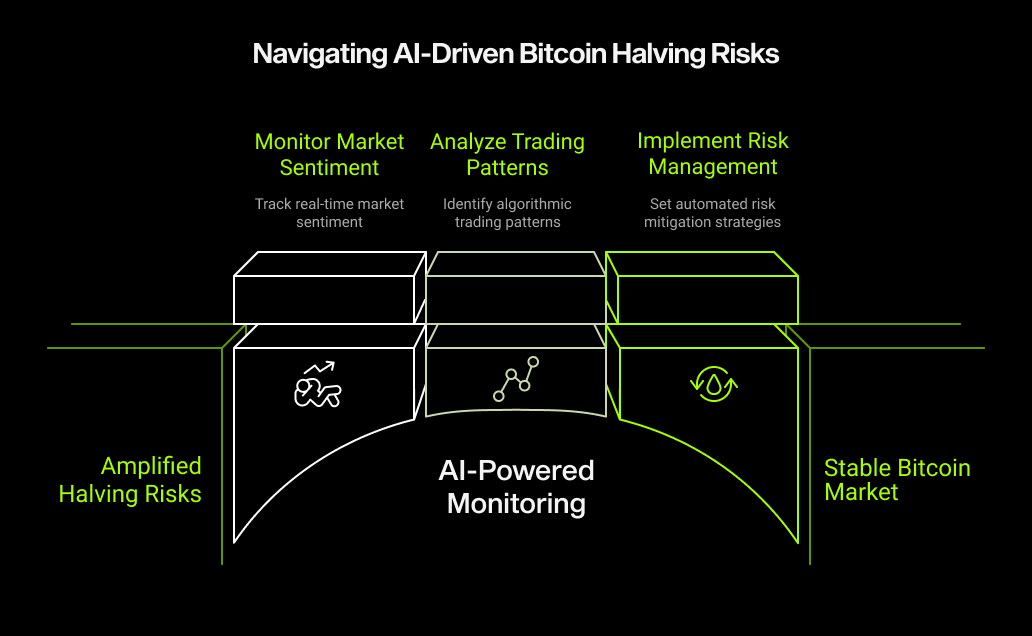
Navigating Al-Driven Bitcoin Halving Risks
On the bright side, there's a lot of excitement around where Bitcoin could go in the coming months and years, especially as we ride the wave from the 2024 halving.
Analysts are throwing out some pretty bold predictions for the end of 2025, with many seeing BTC climbing to between $145,000 and $250,000, driven by ongoing supply squeezes, more ETF inflows, and yes, AI making trading smarter and more efficient.
Some even go as high as $1 million if everything lines up perfectly, like with broader adoption and favorable regulations.
This optimism comes from the halving's historical momentum, where reduced supply meets growing demand from institutions using AI to spot opportunities early. It's easy to imagine a scenario where AI helps stabilize prices by predicting trends and balancing trades, potentially turning the next cycle into a steady climb rather than a rollercoaster.
But let's flip the script to the potential downsides, because this is where the "disaster" part comes in.
If AI trading gets too over-optimized - meaning algorithms all tuned to chase the same patterns - it could actually make things worse by causing flash crashes or amplifying normal corrections into massive drops.
Picture this: a bunch of AI bots detect a small market signal, like a dip in sentiment, and they all sell off at once, creating a cascade effect that tanks prices in minutes before bouncing back.
We've seen echoes of this in past events, like the 2010 stock market flash crash blamed on algorithmic trading, and more recent crypto dips where AI-driven liquidations wiped out billions.
In crypto, where markets are already more volatile, this could turn a standard post-halving correction into something that feels like a full-blown disaster, especially if external factors like economic slowdowns or regulatory changes pile on.
Looking ahead to the next halving around 2028, AI might exacerbate this volatility even more as adoption grows. With institutions relying on AI for up to 40% of their trading decisions, we could see bubbles inflate faster than ever, only to burst when the algorithms herd together in panic mode.
Throw in things like geopolitical tensions or shifting interest rates, and the traditional halving boost might get overshadowed by these AI-amplified swings, leaving unprepared investors caught off guard. It's not all doom and gloom, though - AI could also prevent some of this by offering better early warnings and risk assessments, but that is to be seen.
At the end of the day, these scenarios highlight how AI is a double-edged sword: it could push Bitcoin to new heights or trigger the kind of rapid, unpredictable moves that wipe out gains overnight.
That's why staying informed is crucial, and tools like Ozak AI’s Predication Agents can make a real difference in spotting those risks before they hit.
Expert Warnings
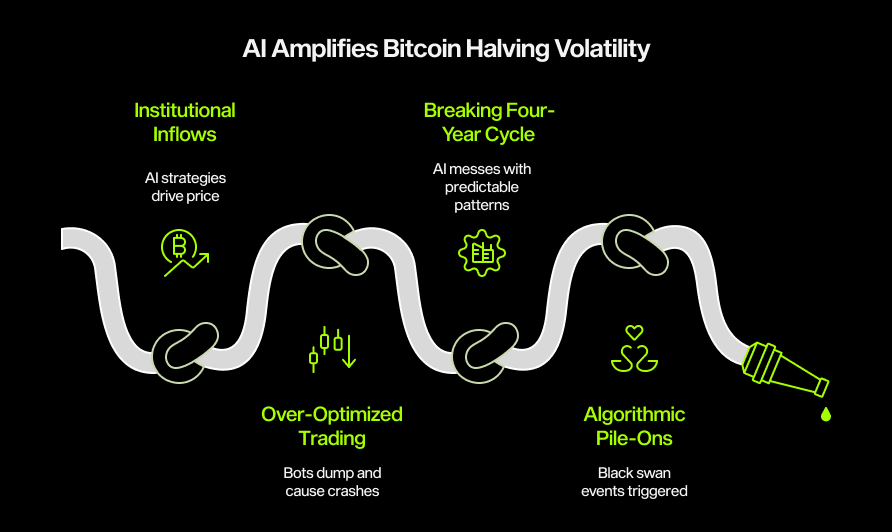
Al Amplifies Bitcoin Halving Volatility
This is not just speculation from folks like us at Ozak AI - plenty of experts are chiming in on how AI could shake up the Bitcoin market, especially around halvings.
For instance, some analysts point out that institutional inflows, often powered by AI strategies, are already playing a big role in price movements. Reports suggest these inflows could account for a substantial chunk of Bitcoin's returns, with estimates showing that even a small percentage of global institutional money - say, around 1% - could push prices way higher, but also introduce more swings if AI algorithms start overreacting.
This ties directly into post-halving patterns, where the usual supply-driven rally might get disrupted by these big players using AI to time their entries and exits perfectly, or at least try to.
But here's where the warnings get louder: experts are debating whether this AI involvement creates "disaster" level volatility.
Take OpenAI's own AI model, which recently predicted a 30-40% chance that Bitcoin could drop below $100,000 by late 2025, even as it trades around $110,000 now.
That's a stark reminder that AI isn't always a crystal ball - it can highlight risks like over-optimized trading leading to herd behavior, where bots all dump at once and cause flash crashes.
Other analysts, like those at CNBC, are noting that Bitcoin's traditional four-year cycle seems to be breaking down, potentially due to new factors like AI-driven institutional trades messing with the predictable patterns we've seen in past halvings. They argue this could turn normal corrections into something much sharper, especially if economic headwinds kick in.
On the flip side, not everyone sees it as all bad. Some experts believe AI could actually stabilize things if used right, by providing better forecasts and reducing emotional trading.
But the debate rages on, with warnings from places like Bitpanda suggesting Bitcoin might even dip below $80,000 long-term if volatility spikes unchecked. In the context of the next halving around 2028, this means we might see more black swan events triggered by algorithmic pile-ons, rather than the steady bulls runs of the past.
It's a mixed bag, but these voices are urging caution, reminding us that AI amps up both the ups and the downs in crypto.
Historical Parallels
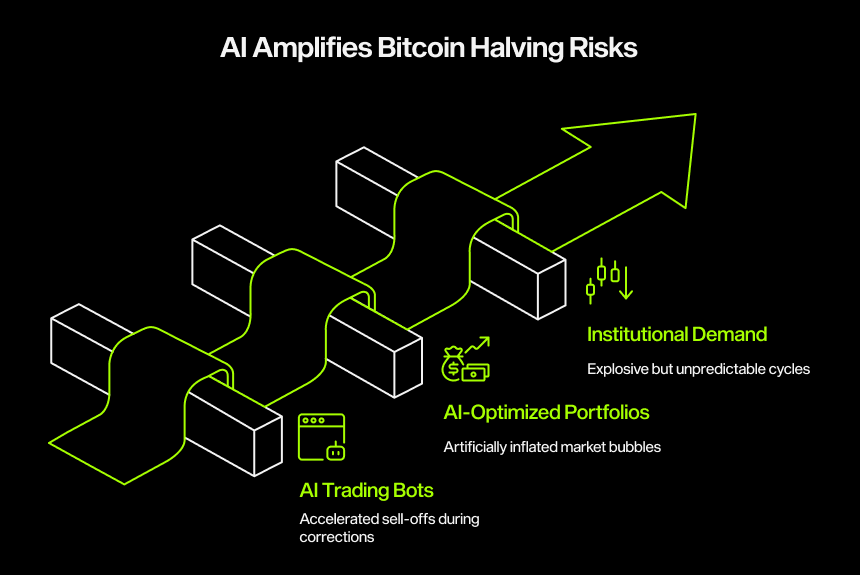
Al Amplifies Bitcoin Halving Risks
To really grasp how AI might change everything for the next Bitcoin halving, it's helpful to look back at what happened in previous cycles and see where things could go off the rails now.
In the early days, like the 2012 halving, Bitcoin was mostly a retail investor playground - prices jumped from about $12 to over $1,000 in a year, driven by hype and scarcity without much big money or tech involved.
The 2016 event followed a similar path: a short dip, then a massive rally into 2017, but it ended with the infamous 2018 crash where BTC dropped over 80% as the bubble burst.
These were fueled by organic demand, with corrections coming from overexcitement and market immaturity.
Fast forward to 2020, and we saw more institutional interest creeping in, leading to a surge to $69,000 in 2021 before another pullback. The pattern was clear: halvings sparked booms, but crashes followed when reality set in.
Now, in 2025, things feel different because AI and big institutions are adding layers that could amplify those old risks. Past cycles were slower, giving retail traders time to react, but today, AI bots can execute trades in milliseconds, potentially turning a minor dip into a rapid crash like we saw in some 2022 liquidations.
For example, the 2018 bear market took months to unfold, but with AI over-optimizing strategies, we might see flash events where algorithms all pile out at once, making corrections deeper and quicker.
This year's post-2024 halving rally has already pushed Bitcoin up steadily, but experts worry AI could inflate bubbles faster, leading to sharper bursts if sentiment shifts.
It's like comparing a slow-burning fire to one doused in gasoline - the basics are the same, but the intensity is cranked up.
On top of that, external factors like geopolitical tensions and interest rate policies are becoming bigger drivers than the halving itself, overshadowing the traditional supply squeeze.
In past cycles, things like the 2018 trade wars added pressure, but now with ongoing global issues - think Middle East conflicts or U.S.-China relations - crypto is more sensitive as a "risk-on" asset.
Lower interest rates have historically boosted prices by making borrowing cheaper and encouraging investment in high-risk stuff like BTC, but if rates stay high or geopolitics heat up, it could tank sentiment overnight.
AI might make this worse by reacting en masse to news, creating volatility that feels like a disaster compared to the more isolated halving effects of yesteryear.
But hey, if we learn from history, using AI for better monitoring could help navigate these storms instead of getting swept away.
Preparation Strategies
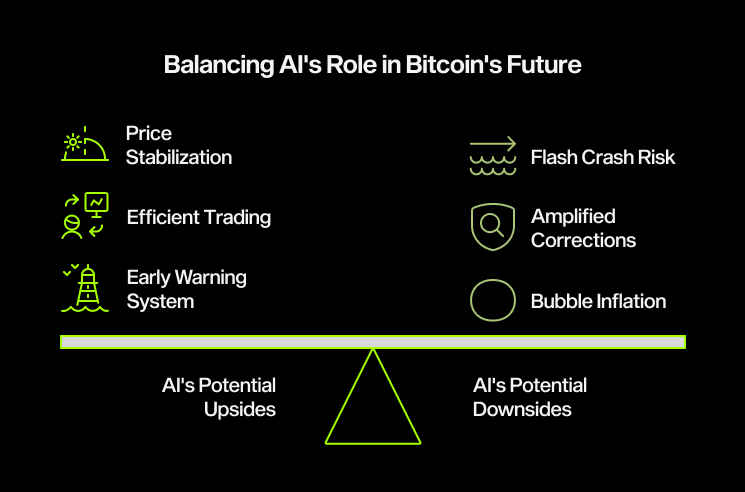
Balancing Al's Role in Bitcoin's Future
So, if all this talk about AI potentially turning the next Bitcoin halving into a volatility nightmare has you worried, don't panic - there are solid ways to prepare and even turn it into an opportunity.
First off, diversification is your best friend when hedging against crypto swings.
Instead of going all-in on Bitcoin, spread your investments across stablecoins like USDT or USDC, other altcoins, or even traditional assets like stocks and bonds to cushion the blow if BTC takes a dive. This way, if AI-driven sell-offs cause a flash crash, you're not wiped out - you can use those stable holdings to buy back in at lower prices.
Another key move is leveraging AI tools for real-time monitoring and smarter decision-making, which can help you stay ahead of the chaos.
At Ozak AI, our predictive agents and data vaults are built exactly for this - crunching financial market trends to give you forecasts that could warn of those over-optimized AI herd behaviors before they hit.
And with our presale in phase 5 right now at just $0.01 per $OZ token (that's a 10x from phase 1's $0.001 for early folks), getting in now could give you access to these tools as we roll them out, turning potential disasters into informed trades.
Finally, build a long-term mindset with clear goals and risk management strategies to make the most of it.
Study past halvings, monitor news on geopolitical stuff or rate changes that could amp up volatility, and use AI for ongoing insights rather than chasing quick wins.
Whether Bitcoin skyrockets to $250,000 or corrects sharply, being prepared means you can pivot - maybe even hedge with cloud mining or AI-managed indices to generate passive income during the turbulence.
It's all about turning knowledge into action, and with the right setup, what looks like a halving disaster could become your biggest opportunity yet.
Conclusion
Wrapping this up, it's clear that AI is set to play a massive role in the next Bitcoin halving cycle, potentially turning what used to be predictable price pumps into something more chaotic and risky.
We've seen how halvings tighten supply and spark rallies historically, but with AI bots, ETFs, and institutional money in the mix, volatility could spike in ways that feel like a real disaster - faster bubbles, sharper crashes, and disruptions from over-optimized trading.
Experts are warning about this shift, and looking back at past cycles shows how external factors like geopolitics and rates are already stealing the show, with AI likely to amplify the ups and downs even more.
But on the flip side, AI isn't just a villain here - it can be the hero if we use it for better predictions and risk management, helping turn those potential pitfalls into smart opportunities.
The key takeaway? Don't sit on the sidelines fearing the worst; get proactive with strategies like diversifying your portfolio and tapping into reliable AI tools to monitor the market.
Whether Bitcoin blasts to $250,000 or faces big corrections, staying informed and adaptable is what will help you come out ahead.
If this got you thinking about the future of crypto and AI, head over to our platform or follow us on X and Telegram for more insights and updates.
Let's turn that "shocking truth" into something exciting - who knows, the next halving might just be your best one yet.
All the best!



